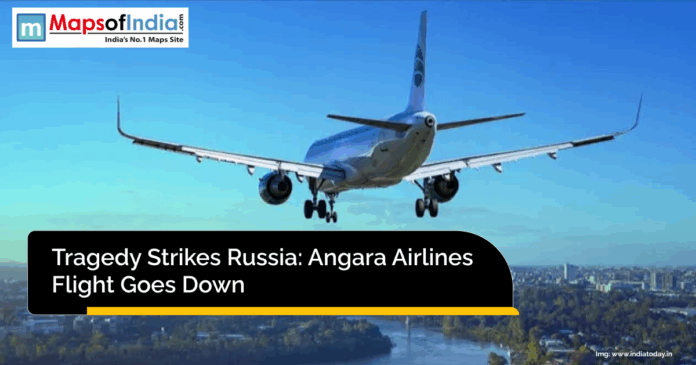In a tragic accident that has shocked Russia and civil aviation observers the world over, one of the planes of Angara Airlines crashed, claiming the lives of numerous people involved. The crash has brought back the burning questions on aviation safety in the region, old fleets and the necessity of fast emergency response systems.
The Crash: What Happened
In what appeared to be just another flight, the Angara Airlines aircraft, a twin-engine turboprop plane that is common in Russia’s remote and difficult terrains, ran into tragic trouble soon after the flight took off. It was a flight that was on its way to another part of Siberia, but it was departing to another regional airport of this region, which is also characterized by harsh weather and poor flight conditions. The plane was hit by a serious engine failure during the flight; thus, the pilot had to engage in emergency back-to-air operation that unfortunately resulted in a crash in the vicinity of the airport.
Witness reports in the early stages state that they saw the plane struggling in the air, its elevation as it went up and down, before it nose-dived and exploded immediately after landing. Firefighters were on the scene, racing to put out the fire and to rescue victims of the disaster.
Casualties and Rescue Operations
There was a quick response to the emergency teams, but due to the location and inaccessibility, they were without control. The unfortunate thing is that the majority of the passengers and employees of the crew perished. Three of the survivors had to be airlifted to the local hospitals in critical condition. The scene at the crash site was an uncertain one with the ambulances, helicopters and fire fighters teaming up to recover the bodies as well as rescue the injured as well and take custody of the aircraft debris to facilitate investigation.
The community around the area, visibly shocked, came to the scene to volunteer in rescue. The Russian government has also announced a day of mourning over the victims, including raising of flags at half-mast, and people have started receiving condolence messages across the world.
About Angara Airlines
Angara Airlines is a local airliner located in Irkutsk with a reputation for providing flights in the enormous territory of Siberia. The aircraft that the carrier has historically used (e.g. Antonov An-24 and An-26) are, in essence, solid and robust, but according to the contemporary standards of the aviation industry, they are obsolete. The planes are very well prepared to land on the rough runway, fly under extreme weather conditions, but the use of the planes has been criticized a lot because of their outdated technology and safety.
Angara Airlines Although Angara has had a good reputation over the years, it, just like other regional carriers in Russia, has been questioned based on its use of older planes which may not be of international safety standards. There is poor maintenance, exhaustion of the crew, and lack of infrastructure in areas that are remote all of which increase the risks.
Preliminary Investigation and Possible Causes
A full-scale investigation into the crash was announced by the Russian Federal Air Transport Agency (Rosaviatsiya). The site has managed to retrieve black boxes which are under analysis in a bid to identify the final moments of the flight. The cause under investigation has a range of possible reasons, among which:
- Engine failure: Witnesses testified to strange noises in the aircraft that happened sometime before it started dropping at a high speed.
- Weather patterns: weather in Siberia is unpredictable, which is dangerous to smaller types of aircraft.
- Pilot error or equipment failure: These two aspects will have to wait to be investigated until the flight data recorders are analyzed.
The airline has also grounded other related planes in its fleet as a precautionary measure as the investigation waits to be concluded.
Reactions from Officials and Public
The air crash has triggered nationwide mourning and anxiety in Russia. President Vladimir Putin also released a message to the families of the victims to show his sympathies, and the government was advised to look closely into the issue. Transportation Minister Vitaly Savelyev also went to the place of the crash and assured the residents of the truth.
The reaction of the public has moved between sadness to outrage especially over the persistence of older planes in the regional fleet. Safety champions in the aviation industry are encouraged to expedite the modernization of the regional aviation industry in Russia, which according to them, was a result of the systemic laxity, and the Angara accident was a serious elucidation.
Recurring Aviation Safety Issues in Russia
It is not the only such tragic event. Russia with its extensive geography and adverse weather conditions depends largely on local air transportation in order to reach distant societies. Unluckily, most of the airplanes that fly the routes are more than decades old, and modernization has been occurring rather sluggishly.
In the last ten years Russia has experienced a number of aviation accidents as the result of either smaller carriers or old aircraft. In spite of the government commitment towards reforms, the state of reform is erratic. The Angara Airlines shift therefore is not just a one off tragedy it is but it has been a pointer of the safety weakness of the aviation sector in the country.
The Human Side of the Tragedy
Every figure in the casualty list tells a story of a life that has been lost, family that has been bereaved, and a community that has lost its loved one. The dead included business travelers, families going to visit relatives, and long-term air crew members who had years of flying behind them. Emotional tributes, accounts of the victim’s lives and calls demanding justice and accountability have been flooding social media.
Rescued individuals are said to be in trauma care departments, where they fight not only bodily harm, but also the shock of the incident. Psychological guidance groups have been sent to help the affected families and communities due to the crash.
What Comes Next
Harm to lives and properties has been the result of the Angara Airlines crash, which will most probably lead to an alteration in aviation policy. Over the next few weeks, investigators will present an in-depth report, and there are predictions that recommendations to strengthen aircraft maintenance, crew training, and emergency planning will come along the way.
The authorities can think of retiring some older aircraft models and giving financial incentives to the regional airlines to change to newer aircraft models. There is also the increasing demand to develop better infrastructure in distant airports to make take offs and landings safer in adverse conditions.
Aviation watchdogs are also keeping a close eye on the international scene as organizations like the International Civil Aviation Organization (ICAO) would be likely to comment on the crash and how this would affect the safety standards of international air travel.
Conclusion
The turbulent past is a ruin left behind by the crash of Angara Airlines flight. As a nation we mourn the loss of innocent lives, but now attention must focus on the bigger structural problems that led to this. Tragedy may be the most cruel teacher, but if it promotes profound reform and rise to safety standards, then loss at least put in motion a better future for Russia’s regional aviation.
Lives lost cannot be brought back, but their memories must guide us toward safer skies.




